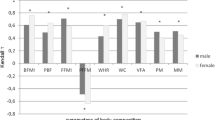Abstract
Childhood obesity is one of the most serious public health challenges of the 21st century. Obesity is a state in which body fat accumulates to an abnormal degree, and detailed information about body composition is necessary to investigate the problems of obesity in children. In the present study, we measured body composition using equipment based on the multifrequency bioelectrical impedance analysis method to measure lean body mass and the quantity of fat. We evaluated differences in body composition in young children from 3 to 5 years old, including differences in relation to gender, and correlated them with measured values of BMI. The fat percentages in girls were higher than in boys, and the muscle percentages (muscle mass/weight × 100) were the opposite. These results show that there were differences in relation to gender. Our evaluations were based on regression analysis of fat percentages in relation to BMI and muscle percentages. A high correlation was found between BMI and fat percentage. The relationship between BMI and muscle percentage was the opposite of the relationship between BMI and fat percentage, and there was a high negative relationship between boys and girls. A significant regression tendency was confirmed from the results of the regression analysis of fat and muscle percentages for BMI in preschool children. This suggests that BMI can also be used to evaluate the fatness or thinness of a preschool child. In short, BMI can be used as an index that can be used to evaluate fat and muscle percentages from early childhood.
Similar content being viewed by others
References
de Onis M, Blossner M, Borghi E (2010) Global prevalence and trends of overweight and obesity among preschool children. Am J Clin Nutr 92:1257–1264
Ministry of Education, Culture, Sports, Science and Technology (2011) Japanese school hygiene statistics investigation. Abstract of the result for 2010. http://www.mext.go.jp/b_menu/toukei/chousa05/hoken/kekka/k_detail/1303380_htm. Accessed 27 Sept 2011 (in Japanese)
Keys A, Fidanza F, Karvonen MJ et al (1972) Indices of relative weight and obesity. J Chronic Dis 25:329–343
Garrow JS, Webster J (1985) Quetelet’s index (W/H2) as a measure of fatness. Int J Obes Relat Metab Disord 9:147–153 12
Hattori K (2006) Body mass index and body composition during growth stages. Jpn Soc Phys Educ 51:435–446 (in Japanese)
Mei Z, Grummer-Strawn LM, Pietrobelli A et al (2002) Validity of body mass index compared with other body composition screening indexes for the assessment of body fatness in children and adolescents. Am J Clin Nutr 75:978–985
Freedman DS, Khan LK, Serdula MK et al (2004) Inter-relationships among childhood BMI, childhood-height, and adult obesity: The Bogalusa Heart Study. Int J Obes Relat Metab Disord 28:10–16
Fukunaga T (2003) The muscular strength development of children. J Growth Dev Child 1:78–84 (in Japanese)
Sugiyama M (2003) The development of physique and body composition in primary school children and junior high school students. J Growth Dev Child 1:268–274 (in Japanese)
Otoki K, Komiya S, Teramoto K et al (1999) Gender differences in body fat distribution of 3- to 6-year-old Japanese children. Jpn Phys Fitness Sports Med 48:641–650 (in Japanese)
Eto C, Komiya S, Otoki K, Teramoto K (2002) Annual changes in body fat of young Japanese children. Jpn J Physiol Appl Hum Sci 7:55–61 (in Japanese)
Teramoto K, Otoki K, Komiya S (1999) Age-related changes body composition of 3- to 6-year-old Japanese children. Appl Hum Sci 18:153–160 (in Japanese)
Nagamine S (1972) Diagnosis of obesity from subcutaneous fat deposition. J Jpn Med Assoc 68:919–924 (in Japanese)
Sakaida M, Fujii K, Akimaru T et al (2007) Relationship among body composition, and change of body composition and bone mineral density (SOS value) with age in preschool children. Jpn J Hum Growth Dev Res 35:1–9 (in Japanese)
Sakai T, Demura T, Fujii K (2009) Validity of fat percentage evaluation for fat-thin judgement derived from standard weight in preschool children. Sport Sci Health 5:105–112
Tanaka K, Fujii K, Ishigaki T, Asauchi D (2008) An approach to evaluation chart of physical fitness based on difference of body form quality in junior high school boys. Tokai Annu Rep Health Phys Educ 30:33–42 (in Japanese)
Matsuura Y, Kim M (1991) Analysis of physical growth by fitting the polynomial to the longitudinal growth distance data of individual — age 6 to 17. Research Monograph issued by the Growth and Development Research institute of Health and Sports Sciences. University of Tsukuba, pp 1–153
Largo RH, Gasser T, Prader A et al (1978) Analysis of the adolescent growth spurt using smoothing spline functions. Ann Hum Biol 5:421–434
Fujii K, Sakai T (2009) Consideration of the canalization effect based on physical factors of mothers and their children. Physical factors of mothers related to physical growth in young children. Sport Sci Health 5:1–7
Author information
Authors and Affiliations
Corresponding author
Rights and permissions
About this article
Cite this article
Sakai, T., Demura, S. & Fujii, K. Relationship between body composition and BMI in preschool children. Sport Sci Health 7, 5–12 (2012). https://doi.org/10.1007/s11332-012-0105-x
Received:
Accepted:
Published:
Issue Date:
DOI: https://doi.org/10.1007/s11332-012-0105-x




